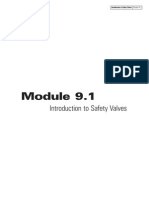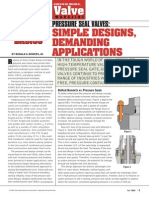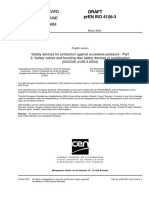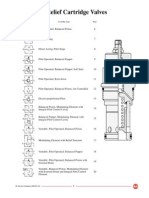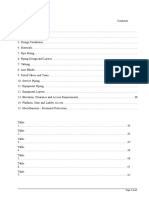The Basics of Pressure Relief Valves
The Basics of Pressure Relief Valves
Uploaded by
Sud GawaliCopyright:
Available Formats
The Basics of Pressure Relief Valves
The Basics of Pressure Relief Valves
Uploaded by
Sud GawaliOriginal Title
Copyright
Available Formats
Share this document
Did you find this document useful?
Is this content inappropriate?
Copyright:
Available Formats
The Basics of Pressure Relief Valves
The Basics of Pressure Relief Valves
Uploaded by
Sud GawaliCopyright:
Available Formats
THE BASICS OF PRESSURE RELIEF VALVES
Contents Pressure relief valves (safety relief valves) are designed to open at a preset pressure
and discharge fluid until pressure drops to acceptable levels. The development of the
The History of Pressure Relief Valves safety relief valve has an interesting history.
Pressure Relief Valve in Operation Denis Papin is credited by many sources as the originator of the first pressure relief
Valve Element (poppet valve) valve (circa 1679) to prevent overpressure of his steam powered “digester”. His
Sensing Element (piston or diaphragm)
The Reference Force Element (spring) pressure relief design consisted of a weight suspended on a lever arm. When the
force of the steam pressure acting on the valve exceeded the force of the weight
Design Parameters acting through the lever arm the valve opened. Designs requiring a higher relief
Relief Pressures pressure setting required a longer lever arm and/or larger weights. This simple
Flow Requirements system worked however more space was needed and it could be easily tampered
Fluid used (gas, liquid, toxic or flammable)
Size & Weight with leading to a possible overpressure and explosion. Another disadvantage was
Material premature opening of the valve if the device was subjected to bouncing movement.
Temperature
Direct-acting deadweight pressure relief valves: Later, to avoid the disadvantages of
Beswick Pressure Relief Valve Options the lever arrangement, direct-acting deadweight pressure relief valves were installed
RVD
RVD8
on early steam locomotives. In this design, weights were applied directly to the top
RV2 of the valve mechanism. To keep the size of the weights in a reasonable range, the
BPR valve size was often undersized resulting in a smaller vent opening than required.
Often an explosion would occur as the steam pressure rose faster than the vent
Beswick pressure relief valves can be could release excess pressure. Bouncing movements also prematurely released
viewed at http://catalog.beswick.com pressure.
Direct acting spring valves: Timothy Hackworth is believed to be the first to use direct
acting spring valves (circa 1828) on his locomotive engine called the Royal George.
Timothy utilized an accordion arrangement of leaf springs, which would later be
replaced with coil springs, to apply force to the valve. The spring force could be fine
tuned by adjusting the nuts retaining the leaf springs.
BPR
Refinements to the direct acting spring relief valve design continued in subsequent years in response to the widespread use
of steam boilers to provide heat and to power locomotives, river boats, and pumps. Steam boilers are less common today
but the safety relief valve continues to be a critical component, in systems with pressure vessels, to protect against damage
or catastrophic failure.
Each application has its own unique requirements but before we get into the selection process, let’s have a look at the
operating principles of a typical direct acting pressure relief valve.
RVD RV2
beswick engineering co., inc. | Miniature Fluid Power Products
284 Ocean Rd. | Greenland, NH 03840-2442 | 603-433-1188
www.beswick.com
PRESSURE RELIEF VALVES IN OPERATION
A pressure relief valve is comprised of three functional
elements:
(1) Valve element, typically a spring loaded poppet valve.
(2) Sensing element typically a diaphragm or piston.
(3) Reference force element. Most commonly a spring.
In operation, the pressure relief valve remains normally
closed until pressures upstream reaches the desired
set pressure. The valve will crack open when the set
pressure is reached, and continue to open further,
allowing more flow as over pressure increases. When
upstream pressure falls a few psi below the set pressure,
the valve will close again.
(1) VALVE ELEMENT (poppet valve)
Most commonly, pressure relief valves employ a spring
loaded “poppet” valve as a valve element. The poppet
includes an elastomeric seal or, in some high pressure
designs a thermoplastic seal, which is configured to
make a seal on a valve seat. In operation, the spring and
upstream pressure apply opposing forces on the valve.
When the force of the upstream pressure exerts a greater
force than the spring force, then the poppet moves away
from the valve seat which allows fluid to pass through the
outlet port. As the upstream pressure drops below the
set point the valve then closes.
Additionally, for a particular relief valve size, it is often
(2) SENSING ELEMENT (piston or possible to provide a greater sensing area with a
diaphragm) diaphragm design than would be feasible with a piston
Piston style designs are often used when higher relief style design.
pressures are required, when ruggedness is a concern
or when the relief pressure does not have to be held to a
(3) THE REFERENCE FORCE ELEMENT
tight tolerance. Piston designs tend to be more sluggish,
(spring)
compared to diaphragm designs due to friction from the
The reference force element is usually a mechanical
piston seal.
spring. This spring exerts a force on the sensing element
and acts to close the valve. Many pressure relief valves
In low pressure applications, or when high accuracy is
are designed with an adjustment which allows the user to
required, the diaphragm style is preferred. Diaphragm
adjust the relief pressure set-point by changing the force
relief valves employ a thin disc shaped element which is
exerted by the reference spring.
used to sense pressure changes. They are usually made
of an elastomer, however, thin convoluted metal is used
in special applications. Diaphragms essentially eliminate
the friction inherent with piston style designs.
beswick engineering co., inc. | Miniature Fluid Power Products
284 Ocean Rd. | Greenland, NH 03840-2442 | 603-433-1188
www.beswick.com
DESIGN PARAMETERS
RELIEF PRESSURES FLOW REQUIREMENTS
The expected relief pressure is an important factor What is the maximum flow rate that the application
in determining which product is best suited to the requires? How much does the flow rate vary? Porting
application. configuration and effective orifices are also important
considerations.
FLUID USED - (GAS, LIQUID, TOXIC, SIZE & WEIGHT
or FLAMMABLE) In many high technology applications space is limited
The chemical properties of the fluid should be and weight is a factor. Some manufactures specialize
considered before determining the best materials for in miniature components and should be consulted.
your application. Each fluid will have its own unique Material selection, particularly the relief valve body
characteristics so care must be taken to select the components, will impact weight. Also carefully
appropriate body and seal materials that will come consider the port (thread) sizes, adjustment styles,
in contact with the fluid. The parts of the pressure and mounting options as these will influence size and
relief valve in contact with the fluid are known as the weight.
“wetted” components.
If the fluid is flammable or hazardous in nature the
pressure relief valve must be capable of discharging it
safely.
MATERIALS TEMPERATURE
A wide range of materials are available to handle The materials selected for the pressure relief valve not
various fluids and operating environments. Common only need to be compatible with the fluid but also must
pressure relief valve component materials include be able to function properly at the expected operating
brass, plastic, and aluminum. Various grades of temperature. The primary concern is whether or not
stainless steel (such as 303, 304, and 316) are the elastomer chosen will function properly throughout
available too. Springs used inside the relief valve are the expected temperature range. Additionally, the
typically made of music wire (carbon steel) or stainless operating temperature may affect flow capacity and/or
steel. the spring rate in extreme applications.
Brass is suited to most common applications and is
usually economical. Aluminum is often specified when
weight is a consideration. Plastic is considered when
low cost is of primarily concern or a throw away item
is required. Stainless Steels are often chosen for use
with corrosive fluids, when cleanliness of the fluid is a
consideration or when the operating temperatures will
be high.
RVD8
Equally important is the compatibility of the seal
material with the fluid and with the operating
temperature range. Buna-n is a typical seal material.
Optional seals are offered by some manufacturers and
these include: Fluorocarbon, EPDM, Silicone, and
Perfluoroelastomer.
beswick engineering co., inc. | Miniature Fluid Power Products
284 Ocean Rd. | Greenland, NH 03840-2442 | 603-433-1188
www.beswick.com
BESWICK PRESSURE RELIEF VALVE OPTIONS
Beswick Engineering manufactures four styles of pressure relief valves to best suit your application. The RVD
and RVD8 are diaphragm based pressure relief valves which are suited to lower relief pressures. The RV2 and
BPR valves are piston based designs.
MAXIMUM SOURCE PRESSURE
1. RVD model can be used with inlet pressures up to 80 psig
2. RVD8 model can be used with inlet pressure up to 80 psig
3. RV2 model can be used with inlet pressures up to 500 psig
4. BPR model can be used with inlet pressures up to 500 psig
RELIEF PRESSURE RANGE
1. RVD model cracks open in the (3-30) psig range. Please contact us if you need a
higher setting.
2. RVD8 model cracks open in the (3-30) psig rang. Please contact us if you need a
higher setting.
3. RV2 model cracks open in the (3-30) psig range
4. BPR model cracks open in the (0-400) psig range
MATERIALS OF CONSTRUCTION
A wide range of materials are available but varies between the models.
1. RVD: 303 and 316 stainless steel, brass and aluminum
2. RVD8: 303 stainless steel and brass
3. RV2: 303 and 316 stainless steel and brass
4. BPR: 303 stainless steel, brass and aluminum
PORTING SIZE
10-32 Internal Thread 1. RVD: Inlet and outlet ports are 10-32 UNF internal
2. RVD8: Inlet port is comprised of four 3/64 inch diameter holes and the outlet port is
1/8-27
10-32 UNF external
NPT 3. RV2: Inlet and outlet ports are 10-32 UNF internal
Thread
10-32
4. BPR: Inlet and outlet ports are 10-32 UNF internal for most models
External Type 2: Outlet port is 1/8-27 NPT external (which is also tapped 10-32 internal). Inlet
Thread
port is 10-32 UNF internal.
Type 8: Outlet port is 10-32 UNF external. Inlet port is a 1/32 inch diameter hole.
WEIGHT
1. RVD weighs 25 grams in brass and stainless steel
15 grams in aluminum
2. RVD8 weighs 25 grams in brass and stainless steel
3. RV2 weighs 41 grams in brass and stainless steel
4. BPR weighs 72 grams in brass and stainless steel
33 grams in aluminum
beswick engineering co., inc. | Miniature Fluid Power Products
284 Ocean Rd. | Greenland, NH 03840-2442 | 603-433-1188
www.beswick.com
You might also like
- Oil and Gas Artificial Fluid Lifting TechniquesFrom EverandOil and Gas Artificial Fluid Lifting TechniquesRating: 5 out of 5 stars5/5 (1)
- Technical Guide Introduction To Liquid Pipeline Surge Relief Daniel en 43822 PDFDocument20 pagesTechnical Guide Introduction To Liquid Pipeline Surge Relief Daniel en 43822 PDFVrbank KrabNo ratings yet
- TT US Ctrbal POCk-Oct-2016N PDFDocument10 pagesTT US Ctrbal POCk-Oct-2016N PDFKemalNo ratings yet
- Coiled Tubing Operations at a Glance: What Do You Know About Coiled Tubing Operations!From EverandCoiled Tubing Operations at a Glance: What Do You Know About Coiled Tubing Operations!Rating: 5 out of 5 stars5/5 (2)
- Basics of Pressure Relief Valves, Article, Beswick EngineeringDocument4 pagesBasics of Pressure Relief Valves, Article, Beswick EngineeringAnonymous 818o0FhNpNo ratings yet
- Basics of Pressure RegulatorDocument7 pagesBasics of Pressure RegulatornvhcycoukNo ratings yet
- About Control ValvesDocument17 pagesAbout Control ValvesSaurabh BarangeNo ratings yet
- Surface Subsurface Production Equipments and AccessoriesDocument7 pagesSurface Subsurface Production Equipments and AccessoriesRizwan FaridNo ratings yet
- Function and DesignDocument16 pagesFunction and DesignSeif ElsaieNo ratings yet
- Preguntas y Respuestas Sobre Valvulas CompresorasDocument4 pagesPreguntas y Respuestas Sobre Valvulas CompresorasOdlanier José Mendoza100% (1)
- 3590 - Marine Piping Systems - VALVES On Shipbuilding ApplicationDocument14 pages3590 - Marine Piping Systems - VALVES On Shipbuilding ApplicationZhafira OspNo ratings yet
- BSB-SAFETY-RELIEF-VALVE (PSV Combined With Rupture Disk)Document8 pagesBSB-SAFETY-RELIEF-VALVE (PSV Combined With Rupture Disk)LudiNo ratings yet
- MH74 Hydraulic ActuatorDocument4 pagesMH74 Hydraulic ActuatorZhanibek MuratkanovNo ratings yet
- Dynamic Restraints: Fronek Anchor/Darling Enterprises, Inc., An ASME "NS"Document2 pagesDynamic Restraints: Fronek Anchor/Darling Enterprises, Inc., An ASME "NS"mih1No ratings yet
- Valve PDFDocument18 pagesValve PDFDipakkumarNo ratings yet
- Relief Valves and Relief SystemsDocument11 pagesRelief Valves and Relief SystemsWisnu KaryadinataNo ratings yet
- Pilot-Operated Safety Relief Valves A Simple, Effective Plant Upgrade - HP - Nov 2011 PDFDocument5 pagesPilot-Operated Safety Relief Valves A Simple, Effective Plant Upgrade - HP - Nov 2011 PDFonizuka-t2263No ratings yet
- 08 Fluid Kinetic Energy As A Selection Criteria For Control Valves - FEDSM97-3464Document9 pages08 Fluid Kinetic Energy As A Selection Criteria For Control Valves - FEDSM97-3464SanjaySherikarNo ratings yet
- 3841Document10 pages3841Gỗ MộcNo ratings yet
- Safety ValveDocument15 pagesSafety ValveMarcelene Justine DionisioNo ratings yet
- Introduction To Safety Valves Spirax SarcoDocument70 pagesIntroduction To Safety Valves Spirax SarcoJuan LucenaNo ratings yet
- Valve Selection For The Safe Operation Protection of The Pump Station 012322Document3 pagesValve Selection For The Safe Operation Protection of The Pump Station 012322zoupezeenNo ratings yet
- Reliability Testing of Pressure Relief Valves: January 2004Document12 pagesReliability Testing of Pressure Relief Valves: January 2004Gama MuktiNo ratings yet
- Pressure Relief AplicationsDocument3 pagesPressure Relief AplicationsAndres PerezNo ratings yet
- Writeup On Safety Valve Erv PDFDocument28 pagesWriteup On Safety Valve Erv PDFSravan DasariNo ratings yet
- PSV Safety Valves IntroductionDocument12 pagesPSV Safety Valves IntroductionKachi Ike100% (1)
- SpiraxSarco-B9-Safety ValvesDocument82 pagesSpiraxSarco-B9-Safety Valvesdanenic100% (4)
- Safety Concerns: Relief Valves, Corrosion, and Safety TripsDocument12 pagesSafety Concerns: Relief Valves, Corrosion, and Safety TripsAbhimanyu SharmaNo ratings yet
- Catalog KSPCDocument20 pagesCatalog KSPCThomas WilliamNo ratings yet
- Relief Valves System and SelectionDocument8 pagesRelief Valves System and Selectionbeqs100% (2)
- Design of Pressure Vessels Under ASME Section VIIIDocument122 pagesDesign of Pressure Vessels Under ASME Section VIIIAvinash BNo ratings yet
- E380b PDFDocument12 pagesE380b PDFanaNo ratings yet
- Bellow Design 1Document5 pagesBellow Design 1zingalala100% (2)
- Butterfly Valves: Uses, Types, Working, Advantages, Symbols: Skip To ContentDocument9 pagesButterfly Valves: Uses, Types, Working, Advantages, Symbols: Skip To ContentVinay SharmaNo ratings yet
- Rowe 1969Document9 pagesRowe 1969g.suraj2003No ratings yet
- Accumulator TheoryDocument20 pagesAccumulator TheoryJoe Jian An Lim100% (2)
- ICH3800 Class 7: 1st Semester 2022Document92 pagesICH3800 Class 7: 1st Semester 2022catalinaNo ratings yet
- Pressure Relief With Rupture DiscsDocument3 pagesPressure Relief With Rupture DiscsValesh MonisNo ratings yet
- Anupam Catalouge Check Valve SelectionDocument7 pagesAnupam Catalouge Check Valve Selectionsunil bajpaiNo ratings yet
- Clarifying Nozzle Load and Piping PDFDocument4 pagesClarifying Nozzle Load and Piping PDFMuhammad ImranNo ratings yet
- G101 Glossary of TermsDocument2 pagesG101 Glossary of TermsVincent IrawanNo ratings yet
- Title: Effects of Valve Trim Geometry in Flashing ServiceDocument7 pagesTitle: Effects of Valve Trim Geometry in Flashing ServiceRamy KamalNo ratings yet
- Control-Valve-Handbook-En-3661206 Pages 151-160Document10 pagesControl-Valve-Handbook-En-3661206 Pages 151-160trevNo ratings yet
- BHMY 887 Flexflo IOM 31683C 0920 EnglishDocument16 pagesBHMY 887 Flexflo IOM 31683C 0920 EnglishSajjad MehdiNo ratings yet
- 08 Co 178 Realiance Saf Val 2 LRDocument2 pages08 Co 178 Realiance Saf Val 2 LRAli AliNo ratings yet
- The Rotary Screw Compressor: Ashrae JournalDocument3 pagesThe Rotary Screw Compressor: Ashrae JournalAkhli RahmatullohNo ratings yet
- Rite Sized Check Valves: ASME Class 125 - 2500 1" (25mm) - 60" (1500mm)Document8 pagesRite Sized Check Valves: ASME Class 125 - 2500 1" (25mm) - 60" (1500mm)Eduardo ArrietaNo ratings yet
- Relief Valve: Flare Header or Relief Header To A Central, Elevated Gas Flare Where It Is UsuallyDocument3 pagesRelief Valve: Flare Header or Relief Header To A Central, Elevated Gas Flare Where It Is UsuallyKhaled RabeaNo ratings yet
- DHSV SLB - Tipo Reliance SeriesDocument2 pagesDHSV SLB - Tipo Reliance SeriesRonald Lucas Silva Lefundes OliveiraNo ratings yet
- MS 02 230Document58 pagesMS 02 230Sang RòmNo ratings yet
- Pressure Seal ValveDocument5 pagesPressure Seal ValveWilson WongNo ratings yet
- Swagelok Catalogs EN MS 02 230 PDFDocument58 pagesSwagelok Catalogs EN MS 02 230 PDFFerry BudiNo ratings yet
- Webinar Slides Tank Blanketing 101Document28 pagesWebinar Slides Tank Blanketing 101edgardiaz5519No ratings yet
- Oil & Gas Surface Facilities: Presented by Carlos 6 March 2015Document53 pagesOil & Gas Surface Facilities: Presented by Carlos 6 March 2015Oscar YañezNo ratings yet
- Control-Valve-Handbook-En-3661206 Pages 51-60Document10 pagesControl-Valve-Handbook-En-3661206 Pages 51-60trevNo ratings yet
- Types of Valves in Piping: Types of Valves - Tables to estimate man hours of assemblyFrom EverandTypes of Valves in Piping: Types of Valves - Tables to estimate man hours of assemblyNo ratings yet
- Pneumatic and Hydrautic Conveying of Both Fly Ash and Bottom AshFrom EverandPneumatic and Hydrautic Conveying of Both Fly Ash and Bottom AshNo ratings yet
- Electric Controlled Pressure Relief Valve For Enhanced S - 2024 - Journal of EneDocument12 pagesElectric Controlled Pressure Relief Valve For Enhanced S - 2024 - Journal of Enemosab.backkupNo ratings yet
- Rupture Disc Main PDFDocument4 pagesRupture Disc Main PDFdumpuuNo ratings yet
- Airtek twp200Document76 pagesAirtek twp200Walter Simms JuniorNo ratings yet
- Pressure Relief Valves PRV Pressure Loading Valves PLVDocument2 pagesPressure Relief Valves PRV Pressure Loading Valves PLVMostafa RaedNo ratings yet
- Pha ChecklistDocument36 pagesPha ChecklistAhmed AtefNo ratings yet
- 67C Series Instrument Supply RegulatorsDocument12 pages67C Series Instrument Supply Regulatorsanthony RodriguezNo ratings yet
- EN ISO 4126-3 - eDocument16 pagesEN ISO 4126-3 - eDH BNo ratings yet
- Siemens Best Practices For Flare QRA Tools PDFDocument11 pagesSiemens Best Practices For Flare QRA Tools PDFDharmadasNo ratings yet
- Sabp J 600Document15 pagesSabp J 600mohamed salahNo ratings yet
- 2024 GroupE ReactorDocument58 pages2024 GroupE Reactorsait.sevincccNo ratings yet
- High Pressure Specialty ValvesDocument19 pagesHigh Pressure Specialty ValvesdbmingoNo ratings yet
- Safety Relief Valve - Selection, Operation & TroubleShootingDocument2 pagesSafety Relief Valve - Selection, Operation & TroubleShootingMohamed AlkhawagaNo ratings yet
- CatalogeChiller CarrierDocument32 pagesCatalogeChiller CarrierPhạm ĐạtNo ratings yet
- Brochure - FNC - Breather Vent To ATM - r2Document2 pagesBrochure - FNC - Breather Vent To ATM - r2asniperforhire100% (1)
- Data Sheet No. 13.07 - 480 - 485 - 490 Safety Valve PDFDocument1 pageData Sheet No. 13.07 - 480 - 485 - 490 Safety Valve PDFGiftObionochieNo ratings yet
- Crosby Pressure Relief Valve EngineeringDocument93 pagesCrosby Pressure Relief Valve EngineeringHuy IpNo ratings yet
- Pompe Beam 435Document24 pagesPompe Beam 435Agustin FavaNo ratings yet
- FM Safety Relief Valve Folder Vsr1n2colour Nov05Document4 pagesFM Safety Relief Valve Folder Vsr1n2colour Nov05jabalpuramit100% (1)
- Lab 1 HydraulicDocument9 pagesLab 1 Hydraulicohoodalfowdaie123No ratings yet
- Relief Cartridge ValvesDocument16 pagesRelief Cartridge Valvesvivek_11111987100% (1)
- PTC and PTF Pivotrol Pump ManualDocument10 pagesPTC and PTF Pivotrol Pump Manualsakura_jNo ratings yet
- Mercer 9100 ManualDocument11 pagesMercer 9100 Manualanara.aidNo ratings yet
- ValvesDocument46 pagesValvesashirNo ratings yet
- GROTH Product Selection GuideDocument12 pagesGROTH Product Selection GuideccglobalincNo ratings yet
- Flare Selection and Sizing (Engineering Design Guideline) : KLM Technology GroupDocument19 pagesFlare Selection and Sizing (Engineering Design Guideline) : KLM Technology GroupDavid GlawsonNo ratings yet
- Piping Design, Layout and Stress Analysis: Foreword 1 Scope 2 Normative References 3 Definitions and AbbreviationsDocument15 pagesPiping Design, Layout and Stress Analysis: Foreword 1 Scope 2 Normative References 3 Definitions and AbbreviationsWalid LabidiNo ratings yet
- Piping Design and Plant LayoutDocument44 pagesPiping Design and Plant Layoutkumarmm1234100% (1)
- Saic-Gi - 2102Document3 pagesSaic-Gi - 2102SUNIL RAJPUTNo ratings yet
- Pressure Relief Device For Manifold 029730037: LegendDocument1 pagePressure Relief Device For Manifold 029730037: LegendMuhammad HassanNo ratings yet
- EIGA - Doc - 217 - 19 - Vacuum-Jacketed - Piping - in - Liquid - Oxygen - ServiceDocument24 pagesEIGA - Doc - 217 - 19 - Vacuum-Jacketed - Piping - in - Liquid - Oxygen - Servicealain100% (1)

























